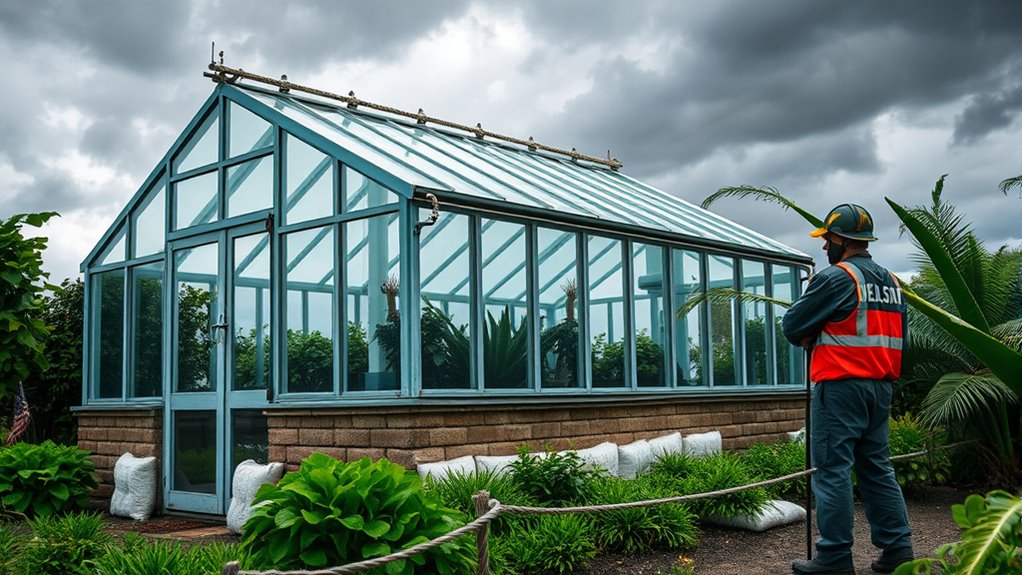To prepare your greenhouse for hurricane or storm season, reinforce its structure with sturdy, wind-resistant materials like reinforced polycarbonate or tempered glass. Anchor the frame securely with heavy-duty stakes or concrete and tighten all panels to prevent uplift. Seal vents, doors, and windows, and add storm shutters or protective films. Remove loose items nearby and keep emergency repair supplies handy. Taking these steps will help safeguard your plants and investment—discover more tips to strengthen your greenhouse further.
Key Takeaways
- Reinforce structure with heavy-duty framing, anchoring, and storm-resistant materials to withstand high winds and hail.
- Secure all panels, vents, and openings with fasteners, storm shutters, or protective films.
- Remove loose outdoor items around the greenhouse to prevent projectiles during storms.
- Regularly inspect and repair any structural weaknesses or damage before storm season.
- Prepare emergency supplies and develop a storm response plan to protect plants and minimize damage.

Hurricane and storm seasons can pose serious threats to your greenhouse, but with proper preparation, you can minimize damage and protect your plants. One of the most effective ways to do this is by investing in windproof structures designed specifically to withstand high winds and flying debris. These structures often feature reinforced frames, sturdy anchoring systems, and aerodynamic designs that reduce wind pressure. When planning your greenhouse, choose designs that prioritize strength and stability, ensuring that it can endure gusts without collapsing or sustaining significant damage. Using storm resistant materials is equally important; opt for heavy-duty polycarbonate panels, tempered glass, or reinforced poly films that resist shattering and tearing. These materials provide durability against strong winds and hail, helping to keep your plants safe and your internal environment stable.
Invest in windproof structures and storm-resistant materials to protect your greenhouse during storms.
Securing your greenhouse is essential before a storm hits. You want to make sure that all panels are tightly fastened, and any loose or weak points are reinforced. Anchor your structure deeply into the ground using heavy-duty stakes, concrete footings, or anchor weights. Consider adding guy wires or straps to further secure the frame, especially if your greenhouse is located in an area prone to intense storms. The goal is to prevent uplift and lateral movement, which can cause structural failure. Additionally, remove any loose items from the surrounding area, such as tools, pots, or outdoor furniture, that could become projectiles during high winds.
Another critical step is to prepare your greenhouse’s ventilation and openings. Seal or reinforce vents, doors, and windows to prevent wind from forcing them open or causing structural damage. Installing storm shutters or removable panels over vulnerable openings can provide extra protection. If your greenhouse has large glass panels, consider adding protective film or shutters that can be quickly installed when a storm is forecasted. Doing this will keep your plants and the interior environment shielded from wind-driven rain and debris. Incorporating wind-resistant features into your design can significantly enhance durability against storms.
Finally, create a detailed emergency plan. Keep a supply of emergency repair materials, such as extra fasteners, sealants, and replacement panels, on hand. Regularly inspect your greenhouse’s structure and materials, especially as storm season approaches, so you can address any weaknesses in advance. By taking these proactive steps—investing in windproof structures, storm resistant materials, securing your setup, and preparing for emergencies—you’ll greatly improve your greenhouse’s resilience against hurricanes and storms. This preparation ensures your plants stay healthy and your investment remains protected, no matter what the weather brings.
Frequently Asked Questions
What Materials Are Best for Storm-Resistant Greenhouse Construction?
For storm-resistant greenhouse construction, you should choose durable materials like galvanized steel or aluminum for the frame, as they withstand high winds and heavy rain. Use reinforced polycarbonate panels or tempered glass for the walls and roof, which provide strength and impact resistance. These storm-resistant materials help your greenhouse endure severe weather conditions, protect your plants, and ensure long-term stability. Proper construction with these materials is essential for storm preparedness.
How Can I Reinforce Greenhouse Doors and Windows Effectively?
Reinforcing your greenhouse doors and windows is like armor protecting a fortress. You should start with storm shutter installation to shield vulnerable areas. Use sturdy door reinforcement techniques, such as adding braces or installing heavy-duty locks, to prevent doors from buckling. For windows, consider shatterproof film or impact-resistant panels. These measures guarantee your greenhouse withstands strong winds and debris, keeping your plants safe during severe storms.
What Emergency Supplies Should I Keep in My Greenhouse?
You should keep an emergency kit stocked with essentials like first aid supplies, bottled water, non-perishable food, flashlights, batteries, and a portable phone charger. Have an evacuation plan clearly outlined and accessible, so you know how to quickly move yourself and valuable plants if needed. Regularly check and update these supplies to guarantee they’re ready when you need them, keeping safety a top priority during storm season.
How Do I Protect Potted Plants During a Storm?
Did you know that over 90% of storm damage to potted plants occurs due to wind and water? To protect your potted plants during a storm, use storm-resistant watering methods to keep them hydrated without excess runoff. Shield your plants with sturdy, wind-resistant coverings, or move them to a sheltered spot. Secure pots firmly, and elevate them off the ground to avoid flooding, ensuring they stay safe through the storm.
When Is the Optimal Time to Secure or Dismantle My Greenhouse Before a Storm?
You should secure or dismantle your greenhouse as soon as seasonal weather forecasting predicts an approaching storm or hurricane. Check your hurricane preparedness checklist regularly, especially when forecasts indicate severe weather. Act early—don’t wait until the storm’s arrival—to prevent damage. By staying vigilant and following the forecast, you can protect your greenhouse and plants efficiently, minimizing potential destruction and ensuring safety before the storm hits.
Conclusion
By taking these steps, you’ll protect your greenhouse like a sturdy fortress against fierce storms. Think of your preparations as a safety net, catching and minimizing damage when nature’s fury strikes. Just as a strong anchor keeps a boat steady amid rough waters, your proactive efforts will keep your plants safe and your greenhouse resilient. With these precautions, you’re better equipped to weather any storm, ensuring your gardening haven remains a haven, no matter what Mother Nature throws your way.









